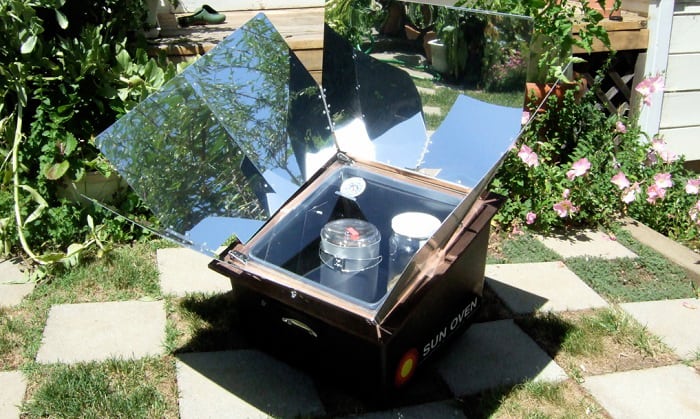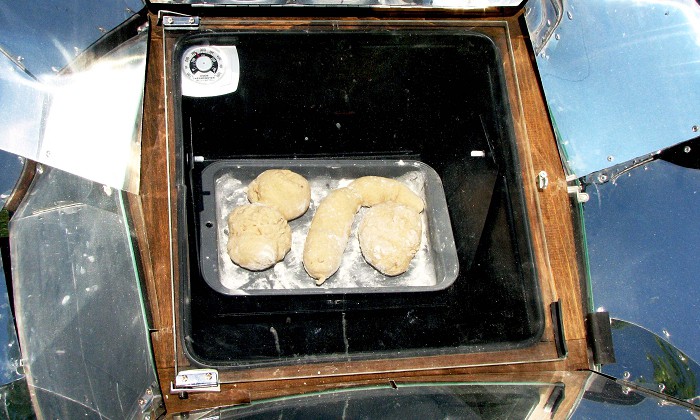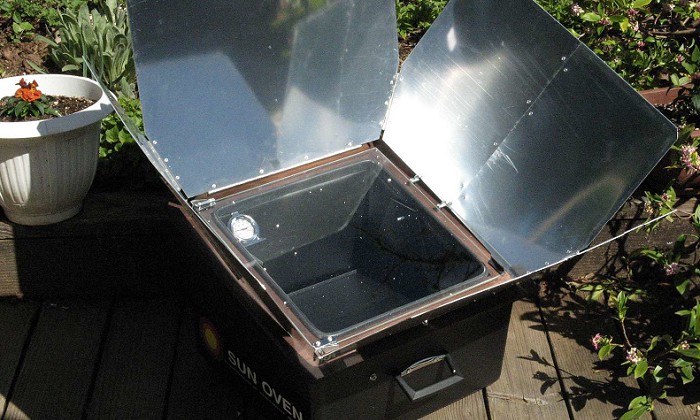The use of solar energy is not limited to lighting and battery charging applications. Nowadays, more people also use solar energy ovens for cooking food, especially when exploring outdoor adventures. But, the question is, how does a solar oven work?
A solar-powered oven works by capturing light particles known as photons to produce heat. This solar cooker is equipped with metal reflectors placed around it for more light input. The primary job of photons is to infiltrate the clear glass top of the solar cooker and hit the interior portion of the insulated box.
Let’s go through this post to dig up more solar oven facts!
Table of Contents
How Does Solar Cooking Work
Solar-powered ovens don’t convert the sun’s energy into electricity; instead, they operate by captivating light particles called photons. The solar oven converts Ultraviolet rays into longer infrared rays. As these lights are locked up, they can heat our food by making all the fat, protein molecules, and water in the oven vibrate intensely.
In other words, we do not use the sun heat or the ambient temperature for cooking our meal, but it’s the converted sun rays into retained energy that does the job.
Different parts of a solar cooker are responsible for specific functions:
- Concentration – The reflecting panels or surfaces are often made of chromium, aluminum, or silver to concentrate UV rays and accumulate heat faster.
- Absorption – Solar cooker interiors and cookware should be dark or black and thin for better heat absorption.
- Retention – The solar oven must be insulated and covered with a lid to avoid heat dissipating.
Did you know that solar-powered ovens work similarly with vehicles left in a parking lot under direct sunlight for an extended time?
The explanation for this phenomenon is known as the greenhouse effect. When the sun’s energy breaks through your car via the windows, it heats the car seats and everything inside your vehicle. This is also how solar ovens work; the only difference is that the tight insulators enable you to cook in an appropriate pot.
We can ensure captivating the approaching light particles with a dark metal pot at the middle portion of the solar cooker. When your cooking pot becomes hotter than the air around it, the heat will try to flee to a cooler spot.
Nonetheless, it’ll be impossible for the heat to pass through the glass barrier, so it has no other choice but to remain inside. The temperature of your solar cooker will increase quickly as heat goes back to the metal pot. The temperature can reach up to 400-degrees F.
The Three Main Types of Solar Cookers
1. Parabolic Cooker
This solar cooker can produce high temperatures faster; however, it’s slightly more complex to build because of its materials and design. To ensure maximum performance, regular realignment of the cooker is necessary.
Please note that when using a parabolic cooker, only a limited food amount is allowed to be cooked at one time.
2. Panel Cooker
This solar cooker commonly has a cooking pot that’s typically blackened. Aside from this, it comes with a clear glass bowl with a reflective panel or an oven cooking bag. The reflective panels are built using a sheet of glossy metal panels, mirrors, tin, or aluminum foil over the ridged carton.
The clear glass bowl or oven bag enables solar energy to infiltrate the food, trap the heat, and keep the heat from fleeing. This type of cooker is generally more straightforward, efficient, and more cost-effective to create. It cooks similarly to a crock or slow cooker, and it cooks roughly 225 to 250-degree Fahrenheit.
3. Box Cooker
This solar oven is similar to a conventional modern oven, wherein you put the food inside an insulated box to trap and retain heat. It is generally constructed using different materials like cardboard, plastic, wood, and many more.
Manufactured box cookers are engineered with the gap and insulation that are ready-made. Box cookers can commonly reach 300-degree Fahrenheit, which is hot enough to cook any food items you want.
What to Keep in Mind When Cooking Using a Solar Cooker
When cooking in a solar oven, make sure that you chop the food items into smaller pieces. This way, it’ll be unnecessary for you to spend more time cooking your food.
Additionally, the position of the solar cooker is also essential to consider; in particular, you have to ensure that the oven is facing the sun. Sometimes, you might need to constantly re-position the cooker to ensure that it gets maximum sun exposure.
Lastly, avoid cooking food that requires more stirring and frequent inspection. If you regularly open the cooker, the cooking time will take longer because heat escapes from the lid.
Are Solar Powered Stoves Functional
At present, solar cooking is highly regarded as the safest, less complex, and most convenient means of cooking food without spending more on fuel. Solar cooking is a clean and cost-effective alternative to heating and cooking food.
Anyone can benefit from using solar ovens. If you’re into outdoor activities like hiking, camping, RVing, etc., you’ll be amazed at how a solar cooker works. Gone were the days when you needed to tirelessly collect wood or droppings to produce heat when cooking while camping, (Read more necessary equipments for camping, for example the trusted solar refrigerators and the top-rated outdoor solar showers).
Essentially, if you wish to reduce your carbon footprint and don’t prefer using gas or electric-powered cooking stoves and ovens, investing in a high-quality solar cooker is ideal.
Should You Purchase or Build Your Solar Oven
Constructing your own solar-powered oven from scratch can be a fascinating and economical means to begin your solar cooking adventure. On the other hand, buying a solar oven is quick and easy, not to mention, buying from trusted brands can ensure getting premium-quality cookers (Learn more about the top-rated solar ovens here).
We strongly suggest referring to “constructing a solar oven page” to select a perfect design suitable for your needs for those who prefer building their solar ovens. What’s more, conducting research can help you gain more valuable ideas on the unique characteristics of each style of a solar oven.
Meanwhile, for those who find purchasing a solar oven from reputable manufacturers preferable, it’s best to first research the best solar cooker manufacturers. This way, you’ll uncover which manufacturers produce the best solar cookers. Fortunately, commercial solar ovens are usually user-friendly, efficient, functional, and built to last.
Final Thoughts
Ultimately, solar ovens are now becoming one of the most preferred cooking methods around the world. Besides being eco-friendly, user-friendly, and efficient, they significantly help users save more on fuel costs.
Now that you know how a pizza box solar oven works, allow us to remind you why solar ovens are advantageous for you:
- Economical alternative, energy-saving, and portable
- Not dependent on electricity to operate and less carbon footprint
- Safe, ideal for off-the-grid lifestyle, built to last
Hopefully, this post about “how does a solar oven work” can help you decide whether or not this type of cooker is suitable for your lifestyle.

As the founder of the Avasolar team, I aspire to solve the problems for households in selecting, installing, and utilizing solar mechanical devices.



